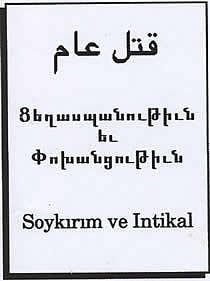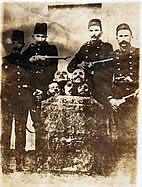-
From the Armenian genocide the author questions herself: if the genocidary project is really that which, beyond the murder of all the living ones of a group, programs the destruction of the very bases of transmission, which are the psychic consequences of such an installation, for the heirs of the survivors?
Indeed, when the genocidary ones, beyond the murder, set up dehumanization then the disappearance of the dead-corpses, do they not try to make any symbolization of Death -in other words any mourning of these dead persons- impossible? Thus forcing their heirs to offer their own bodies as graves?
However is it the rendered death in this way not symbolisable for the heirs of the victims? It is as much for the heirs of the genocidary ones who - at the same time and in this case- inherit a falsification of their history and a denied mass grave of dead persons ?
If so, the heirs of the ones and of the others, would find themselves engaged in the same murder scene which would link them and haunt their imaginary : as an always possible return into Reality, of this genocidary murder which, still denied, remaining like outstanding questions in symbolisation.
Since then, can we ever think that the ones will be able, without the support of the others, to get out of this omnipotent hold which still endured since 1915 and of which they are together the victims ?
|
-
Continuing its reflexion undertaken in its book "Genocide and transmission" and always starting from the genocide of the Armenians the author wonders on the political device of "disappearance" and about its psychic effects on those which remained in life. Why the introduction of the disappearance of the beings then of their body is in the center of the genocidary process, and why is always accompanied T-it by its refusal?
Finally why these last years the exhumation of the mass graves and the identification of these disappeared were of such an importance for their close relations as for the remainder of the population? Thus to start from events as distant in time and space as the genocides from the Armenians, the Jews, the Bosnians, Tutsis but also Vendean Terror and the massacres of Algeria, the author will try to release specificities of this which the "genocidary structure calls" which is common for them and whose couple disappearance-refusal constitutes the core.
In addition throughout this book the interrogation will be present on the particular bond which binds the killers to their victims as being essential with the comprehension of the devastations which this structure involves for the psychism of the descendants of the ones and others.
|

